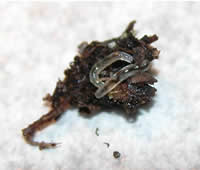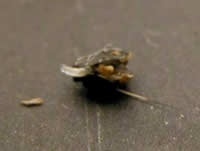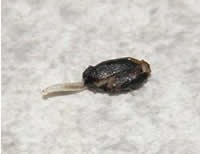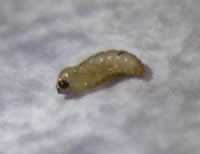
Growing Hosta Seedlings: Potential Problems
Preventing and solving problems encountered while growing Hosta seedlings indoors.
By Joshua Spece
Last revised February 4, 2008
Just like growing Hostas in the garden, growing Hosta seedlings under lights is almost fool-proof. If you follow the advice in this guide (and even if you don't!), your chances of success are good. Occasionally a problem will rear its ugly head, though, and it is good to be prepared.
Damping Off
Damping off is a fungus that infects young seedlings. The fungus causes the stem to turn mushy and rot just above the soil line. Once infected, there is no saving the infected seedlings. Damping off is encouraged by constant moisture and stagnate air.
Prevention is the best way to fight damping off. It is critical to start by sanitizing pots, flats, and the growing mix. If any of these supplies were previously used, there is a very good chance they will carry diseases.
A small fan to circulate the air is a good idea, especially if your growing area is quite warm. Circulating air will help dry excess moisture and make conditions inhospitable to the damping off fungus.
If you find damping off to be especially troublesome, a preventative fungicide will virtually eliminate the problem. After the first leaf is expanded, drench the Hosta seedlings with a fungicide labeled for damping off. This can be repeated every seven to ten days, until the seedlings have two or three leaves. At that stage, damping off is no longer a threat.
It is a good idea to have a fungicide on hand at all times. At the first sign of damping off, drench the seedlings with a fungicide. You can't save already infected seedlings, but you can stop the fungus from spreading to healthy Hosta seedlings.
Fungus Gnats
Fungus gnats are one of the most common problems when growing plants indoors. The tiny, black adults look similar to a fruit fly and the larvae are even tinier, translucent worms that live in the potting mix. The adult gnats are mainly a nuisance, but the larvae feed on roots and can be harmful to small Hosta seedlings.Fungus gnat larvae are even more devastating if they infest a newly sown flat of seeds. Seedlings with three or four leaves have usually grown enough roots to sustain themselves, even with gnat larvae feeding on them. The Hosta seedlings may be stunted and grow poorly, but they can be saved. A newly germinating seed has only one tiny, delicate root that can not be replaced if eaten. Fungus gnat larvae can completely destroy a flat of germinating seeds. If you have fungus gnats, it would be advisable to isolate newly sown seeds away from your main growing area until they have at least three leaves. Keeping newly sown flats securely covered is also an option.
Preventing fungus gnats is much easier than eradicating an infestation. Again, sanitation is key. This is especially true of the growing mix, as this is where the gnats lay their eggs.
Fungus gnat larvae must have a constantly moist potting mix to survive. Maintaining proper soil moisture is the first step in controlling fungus gnats. Never keep the mix soggy and only water once the surface of the potting mix has begun to dry.
Using Bacillus thuringiensis israelensis (BTi) to Fight Fungus Gnats
Fungus gnat larvae are susceptible to Bacillus thuringiensis israelensis (BTi) - a naturally occurring strain of bacteria. BTi is most commonly used to control mosquitoes and is readily available as Mosquito Dunks, Donuts, or Bits. A concentrated liquid form can also be used.The granular Mosquito Bits can be mixed right into your potting mix or sprinkled over the surface. Alternatively, a chunk of a Mosquito Dunk/Donut can be left floating in water and then the Hosta seedlings are watered with it. A five gallon pail can be on hand and always topped up with fertilizer and a Mosquito Dunk, ready to water when needed. The Dunk/Donut should be replaced every couple weeks to ensure the BTi is still active.
BTi is not an instant remedy for established fungus gnats. It is best used as a preventative measure, but will bring an infestation under control in time. The larvae will die shortly after ingesting the bacteria. The bacteria has no effect on adult gnats, though, so they will die naturally over a period of a couple weeks. Once the infestation is under control, do not stop using BTi or the pesky gnats will likely return.
Predatory nematodes can also be used successfully to control fungus gnats. Like BTi, these specialized nematodes are completely harmless to the plants, humans, and animals. The nematodes should be used according to the instructions.
Neither BTi nor predatory nematodes are likely to completely eliminate fungus gnats. Their continued use, though, will keep the gnat population to an almost un-noticeable level. Both of these biological controls are much safer to use indoors than pesticides, but under extreme conditions an appropriate pesticide can be used to quickly reduce the fungus gnat population.
- Introduction to Hybridizing Hostas
- Selecting Parent Plants
Goals, Fertility, Bloom Period - Hosta Genetics
- The Mechanics of Hybridizing Hostas
Flower Anatomy, Preparing & Protecting Flowers
Collecting & Storing Pollen, Transfering Pollen, Marking Crosses, Keeping Records - Hosta Seeds
Harvesting, Cleaning, Storing - Starting Hosta Seeds
Planting Containers, Planting Medium, Moisture, Heat, Germination Time - Growing Hosta Seedlings
Light Type, Photoperiod, Reflecting Light, Water, Fertilizer, Re-potting - Problems Encountered While Growing Hosta Seedlings
Damping Off, Fungus Gnats - Hardening Off & Moving Seedlings Outdoors
- Culling and Selecting Hosta Seedlings
- Hybridizing Resources
All content and images © 2024 by In The Country Garden & Gifts unless otherwise noted.




